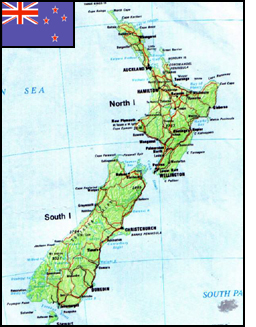 Land area:
Land area: 103,483 sq mi (268,021 sq km);
total area: 103,738 sq mi (268,680 sq km)
Population (2006): 4,076,140 (growth rate: 1.0%); birth rate: 13.8/1000; infant mortality rate: 5.8/1000; life expectancy: 78.8; density per sq mi: 39
Capital City: Wellington
Monetary unit: New Zealand dollar
Languages: English, Maori (both official)
Ethnicity/race: New Zealand European 74.5%, Maori 9.7%, other European 4.6%, Pacific Islander 3.8%, Asian and others 7.4%
Religions: Anglican 24%, Presbyterian 18%, Roman Catholic 15%, Methodist 5%, Baptist 2%, other Protestant 3%, unspecified or none 33% (1986)